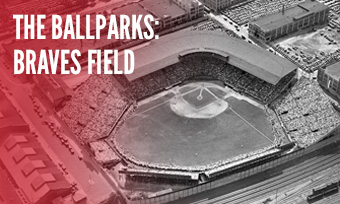THE TEAMS
Boston Red Sox
Known as the Boston Americans, 1901-07
THE RED SOX BY THE DECADE
The 1900s
One of the success stories during the American League’s infancy, the Red Sox (originally called the Americans) won two pennants early in the decade and claimed victory in the first World Series, stunning the powerhouse Pittsburgh Pirates in 1903. Boston was primarily led by the incomparable Cy Young, the portly ace scoffed at by the rival National League at the turn of the century as being too old and fat—all before claiming a solid stake as baseball’s best pitcher of the decade. After a brief freefall from grace, the Red Sox rebounded by decade’s end with a new batch of talent led by shrewd center fielder Tris Speaker.
The 1910s
The Red Sox made their mark as the majors’ pre-eminent team of the decade, winning four world titles behind the emerging brilliance of Speaker and a plethora of pitching stars that began with 34-game winner Smokey Joe Wood and continued with the arrival of the tenacious Dutch Leonard, fractious Carl Mays and a very young Babe Ruth—who ultimately transcended his top-notch abilities on the mound to the plate. More sentimentally, 1912 saw the opening of Fenway Park—which, a century later, still remains as the Red Sox’ home.
The 1920s
The decade was over for the Red Sox before it began when owner Harry Frazee—who held a far bigger passion for Broadway over baseball—sold rising superstar Ruth to the New York Yankees, initiating a virtual one-way pipeline of other worthy Boston talent that created a superpower in Gotham, relegated the Sox to an era of depressive baseball and, according to successive generations of Boston fans, established The Curse—a so-called hex from Ruth that would not be broken until the 21st Century. Not only did the Red Sox fail to produce a winning campaign during the 1920s, they were also the only team in the majors not to turn a profit.
The 1930s
The post-Ruth malaise continued and bottomed out in 1932 with a franchise-worst 43-111 mark before the Red Sox were rescued by new owner Tom Yawkey—who overhauled Fenway Park (adding the iconic Green Monster in left field) and brought genuine talent back to Boston with the additions of star pitcher Lefty Grove, burly slugger Jimmie Foxx and, at decade’s end, the debut of the tall, lanky and peerless Ted Williams. Although Yawkey’s maneuvers failed to yield a pennant—yet—they were at least providing Fenway with long-lost excitement.
The 1940s
The Red Sox continued to just barely lose out in their search for an AL flag—but in the meantime, there was magic aplenty with the maturation of Williams, who became the last .400 hitter to date in 1941 and won four batting titles throughout the decade. His absence during World War II hindered the Sox’ performance, but his return in 1946 generated, finally, the team’s first pennant in nearly three decades before losing a tough seven-game World Series to St. Louis. More frustration came afterward when Boston fell shy of first place by a single game in successive seasons (1948-49).
The 1950s
The highly potent Red Sox offense peaked in 1950 when it scored over 1,000 runs and became the last team to hit over .300. But during the virtually petrified AL of the 1950s, Boston cemented itself as a middle-of-the-pack ballclub that could not chip away at Yankee dominance; an aging Williams, chronically absent due to military duty, injury and/or brief retirement, could by now only do so much to assist a franchise that was struggling to successfully reload beyond fellow MVP contender Jackie Jensen.
The 1960s
After Williams stepped down for good in 1960, the Red Sox entered a stale existence for a good chunk of the decade in front of an increasingly empty Fenway Park, reaching a nadir in 1965 with 100 losses. The cobwebs were suddenly swept aside in 1967 when vibrant young manager Dick Williams re-awoke the Red Sox to a startling AL pennant behind the heroics of triple-crown star Carl Yastrzemski. The Sox fell short again at the World Series (once more in seven games to the Cardinals), but long-term vitality had returned to Boston.
The 1970s
The Red Sox spent much of the 1970s playing second fiddle in the AL East, often in heartbreaking fashion; they finished a mere half-game behind Detroit in 1972 and blew a 14-game lead to the Yankees in 1978, losing a one-game playoff to determine the divisional champ—reviving claims that The Curse was alive and well. Boston did break through to one pennant in 1975 with sensational rookie efforts from Fred Lynn and Jim Rice—but yet again lost a memorable seven-game Fall Classic, this time to Cincinnati in what many hail as the greatest World Series ever.
The 1980s
The winning ways continued in Boston—but apparently so did The Curse. Hall of Famers emerged with five-time batting champ Wade Boggs and fiery ace Roger Clemens, who won his first two of an eventual record seven Cy Young Awards. The Red Sox claimed two divisional titles and reached the World Series in 1986 when, with one out away from a long-sought championship, the dream was shattered with a major breakdown famously highlighted by Billy Buckner’s through-the-legs error at first base—further perpetuating the aura of The Curse.
The 1990s
After another AL East title in 1990, the Red Sox fell into disrepair for the next four years as an unusually anemic offense weighed the team down in the standings. But a post-strike jolt of hitting led by booming Mo Vaughn and shortstop Nomar Garciaparra rejuvenated Boston and aided a pitching staff which, after losing Clemens via trade, re-armed itself towards decade’s end with the addition of Pedro Martinez—the only pitcher putting up deadball-like numbers during the height of the steroid era.
The 2000s
The advent of the wild card became the Red Sox’ salvation, ultimately (and finally) foiling The Curse in historic, mind-blowing fashion. Bulked up with star sluggers Manny Ramirez and David Ortiz, Boston did all it could to break the Yankees’ Goliath-like hold on the AL East but frequently finished second—yet was able to snare the wild card spot five times. Facing the Yankees in the 2004 ALCS, the Red Sox were an inning away from being swept when they launched baseball’s most incredible postseason comeback, overcoming the Yankees and (fittingly) defeating St. Louis for their first world title in 86 years; they won a second World Series three years later against Colorado. Red Sox fans ate it up, selling out every game at Fenway Park from 2003 into the next decade.
The 2010s
A decade of extremes for the Red Sox, with three last place finishes—including a tumultuous 2012 breakdown scarred by a near mutiny—and four divisional crowns highlighted by a galvanized 2013 roster earning a world title to help heel a city reeling from the Boston Marathon terrorist act. Another world title—the Red Sox’ fourth in 15 years—came in 2018 as the team remolded itself around young stars Mookie Betts and Xander Bogaerts, and pricey pick-ups in slugger J.D. Martinez and ace pitchers Chris Sale and David Price.
The 2020s
The ups and downs continued at Fenway as the Red Sox struggled to find a winning groove; not helping was the firing—and rehiring—of manager Alex Cora, suspended by MLB for his role in the 2017 Houston cheating scandal while serving as the Astros’ bench coach. Ownership remains strong and Fenway is popular as ever, but the Red Sox need to redefine roster chemistry and organizational vision—especially in a highly competitive AL East.
Highlights of the Red Sox’ History on This Great Game:
 1903: The First World Series With peace at hand, the American and National Leagues join hands in October and stage the first Fall Classic.
1903: The First World Series With peace at hand, the American and National Leagues join hands in October and stage the first Fall Classic.
 1912: The $30,000 Muffs A series of critical blunders do in the New York Giants against the Red Sox at the World Series.
1912: The $30,000 Muffs A series of critical blunders do in the New York Giants against the Red Sox at the World Series.
 1918: All Work or Fight and No Play Baseball scratches and claws to stay intact as World War I reaches its brutal apex—and the Red Sox win their last World Series for a long, long time.
1918: All Work or Fight and No Play Baseball scratches and claws to stay intact as World War I reaches its brutal apex—and the Red Sox win their last World Series for a long, long time.
 1923: With Regards to Harry The New York Yankees become one of baseball’s great dynasties at the willful expense of the Red Sox and their Broadway-obsessed owner, Harry Frazee.
1923: With Regards to Harry The New York Yankees become one of baseball’s great dynasties at the willful expense of the Red Sox and their Broadway-obsessed owner, Harry Frazee.
 1941: 56, .406 and Dem Bums Joe DiMaggio’s magical hitting streak, Ted Williams’ run at .400 and the rise of the Dodgers result in one of baseball’s most memorable years.
1941: 56, .406 and Dem Bums Joe DiMaggio’s magical hitting streak, Ted Williams’ run at .400 and the rise of the Dodgers result in one of baseball’s most memorable years.
 1967: The Impossible Dream The Red Sox get serious after a decade of living a mediocre, country club-like existence.
1967: The Impossible Dream The Red Sox get serious after a decade of living a mediocre, country club-like existence.
 1975: Birth of a Renaissance America’s passion for baseball is re-awakened with, arguably, the greatest World Series ever between the Red Sox and Cincinnati Reds.
1975: Birth of a Renaissance America’s passion for baseball is re-awakened with, arguably, the greatest World Series ever between the Red Sox and Cincinnati Reds.
 1978: The Denting of the Red Sox Bucky Dent’s improbable 163rd-game heroics cap a feverish late-season comeback by the Yankees over the Red Sox.
1978: The Denting of the Red Sox Bucky Dent’s improbable 163rd-game heroics cap a feverish late-season comeback by the Yankees over the Red Sox.
 1986: An October for the Ages A historic postseason full of comebacks and collapses takes on legendary proportions thanks to the Red Sox’ Bill Buckner.
1986: An October for the Ages A historic postseason full of comebacks and collapses takes on legendary proportions thanks to the Red Sox’ Bill Buckner.
 2003: Curses, Inc. Baseball’s two most famously cursed—the Red Sox and Chicago Cubs—add to their long-suffering legend of heartbreak.
2003: Curses, Inc. Baseball’s two most famously cursed—the Red Sox and Chicago Cubs—add to their long-suffering legend of heartbreak.
 2004: Four Score and Six Years Hence Down 3-0 in the ALCS, the Boston Red Sox burst to life and spectacularly exorcise the Curse of the Bambino.
2004: Four Score and Six Years Hence Down 3-0 in the ALCS, the Boston Red Sox burst to life and spectacularly exorcise the Curse of the Bambino.
 2013: Coming on Strong After two years of internal misery, the Red Sox come together and give an emotional lift to a wounded city with an inspirational championship effort.
2013: Coming on Strong After two years of internal misery, the Red Sox come together and give an emotional lift to a wounded city with an inspirational championship effort.





